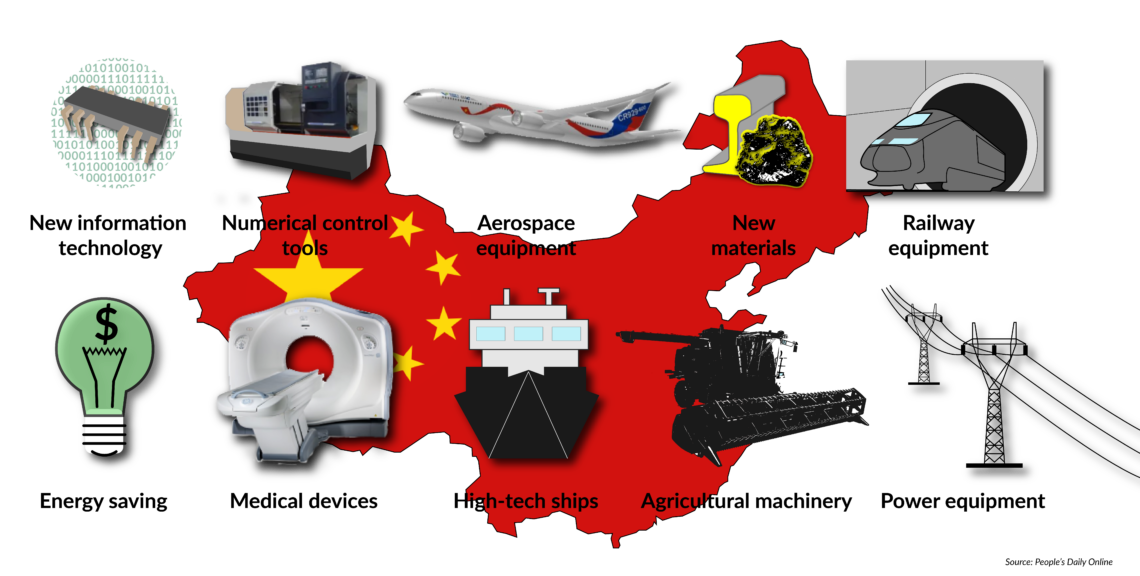A U.S.-China deal won’t end economic uncertainty
The disputes between the U.S.and China are not just about unfair practices. It has deeper roots, with origins in Beijing’s aspiration to become a globally dominant leader in several technology sectors. While a trade deal may be likely before the 2020 election, U.S.-China tensions over technology leadership are only beginning.

In a nutshell
- Washington and Beijing could agree to a deal next year
- Chinese technology policy is at the heart of the tensions
- U.S. worries over tech leadership are here to stay
The U.S.-China economic relationship hit a turning point in 2016 when Chinese outbound investment was at its peak. During that time, not only did China have industrial and economic development policies that irked leaders in advanced Western nations, Beijing also showed it had the financing to back it up. President Donald Trump’s efforts to reshape the U.S.-China trade and economic relationship since then has opened up this growing sense of unease to the public. Now the U.S. and China are in a trade dispute. Whether the Trump administration can sign a trade deal with Beijing or not, however, it is unlikely to resolve this apprehension over China’s policies. U.S.-China economic tensions will likely remain for the foreseeable future, whether President Trump is reelected in 2020 or not.
Origins of the trade war
For the last two years, the Trump administration has pursued efforts to reform not just the U.S.-China trading relationship but Chinese domestic policies and practices they believe harm U.S. commercial interests in China. In August 2017, President Trump directed the U.S. Trade Representative (USTR) to initiate an investigation into China’s unfair commercial practices under the Trade Act of 1974.
China announced it would claim global leadership in 10 sectors.
USTR ultimately determined that several of China’s practices – requiring American businesses to enter into joint ventures with Chinese owners, stealing intellectual property through cyber-means, demanding businesses transfer technology to their Chinese peers, acquiring U.S. technology and limiting businesses’ ability to set their own licensing terms – were unfair, resulted in harm to the U.S. economy of at least $50 billion a year, and therefore warranted punitive measures. Since then, the U.S. and China have had an escalating, tit-for-tat trade dispute.
Facts & figures
U.S.-China trade dispute timeline
- August 14, 2017 – President Trump instructs the USTR to investigate Chinese commercial practices
- July 6, 2018 – First tranche of tariffs: a 25 percent additional tariff on $34 billion worth of Chinese imports into the U.S. China responds with a 25 percent additional tariff on $34 billion worth of U.S. imports
- August 23, 2018 – Second tranche of tariffs: a 25 percent additional tariff on $16 billion worth of Chinese imports. China responds with a 25 percent tariff on $16 billion worth of U.S. imports
- September 24, 2018 – Third tranche of tariffs: a 10 percent additional tariff on $200 billion worth of Chinese imports. China responds with a mix of 5 to 10 percent additional tariffs on $60 billion worth of U.S. imports
- December 1, 2018 – Presidents Trump and Xi meet at the G20 in Argentina and agree to continue trade talks
- May 17, 2019 – USTR begins procedure to add a 25 percent additional tariff on $300 billion worth of Chinese imports
- June 1, 2019 – Fourth tranche of tariffs: the 10 percent tariff on $200 billion worth of Chinese imports from September increases to 25 percent. China responds with additional tariffs between 5 and 25 percent on the previous $60 billion worth of U.S. imports
- June 28, 2019 – Presidents Trump and Xi meet at the G20 in Japan and agree to restart trade negotiations
- September 1, 2019 – Fifth tranche of tariffs: a 15 percent tariff on roughly half of $300 billion worth of Chinese imports. China responds with a mix of 5 to 25 percent additional tariffs on a variety of U.S. imports
Animosity toward China’s presence in the global economy started before the Trump administration, particularly with the 2015 announcement of China’s new industrial policy, “Made in China 2025.” China announced it would claim global leadership in 10 sectors, including information technology, robotics, advanced transportation and new materials. With increasing Chinese investments in advanced technologies in the U.S., Europe and Asia between 2015-2017, the U.S. Congress decided to reform its national security laws around foreign investment and export controls. The U.S. is still in the process of modernizing these rules, and is encouraging allies in Asia and the European Union to adopt similar regulatory frameworks.
The U.S.-China trade dispute originates around Made in China 2025 as well. The first two tranches of tariffs, on $50 billion worth of Chinese imports, were on goods important to this strategic plan and to other Chinese industrial policies. In June, President Trump said he complained to President Xi about Made in China 2025, telling him he found it “insulting.” He further stated that China has since backed off the initiative.
However, U.S. officials see China’s industrial policies and its cybersecurity and intelligence laws as the codification of the Chinese Communist Party’s interests. In other words, the policy is not necessarily dead even if it no longer exists on paper. The U.S. government is still very much concerned about the Chinese acquisition of technology and Made in China 2025. It will continue to monitor and scrutinize Chinese investment activity, regardless of any trade deal.
Scenarios for a deal
The current U.S.-China trade dispute has expanded well beyond what many of its early proponents had anticipated. The trade issue has become more politicized and will continue to be as the U.S. moves closer to its next presidential election. The U.S. and China will never formalize a free trade agreement nor remove all barriers to trade and investment. The Chinese Communist Party relies too much on its ability to leverage China’s state-owned enterprises and rejects relinquishing control to market forces. In this context, what are the likely scenarios for a U.S.-China trade deal?
Facts & figures
Made in China 2025
The 10 key sectors

Scenario one is the best-case scenario, because it not only addresses many of the U.S. complaints about Chinese commercial practices but removes the tariffs that are currently levied on more than $250 billion worth of Chinese imports and $110 billion of U.S. exports. Under this scenario, sometime in the next year, Beijing would agree to further reduce its requirements for U.S. businesses to enter into any joint ventures. It would commit to refrain from currency manipulation and to protect U.S. intellectual property as if it were Chinese intellectual property. It would announce efforts to treat U.S. business in China fairly, become more transparent about its state-owned enterprises’ financing and agree to regular meetings to ensure the deal and any future complaints are addressed accordingly. Both sides would agree to drop any dispute in the World Trade Organization. In addition, Beijing would make additional purchases of U.S. agricultural and industrial goods to help reduce the U.S. trade deficit with China.
Facts & figures
A U.S.-China trade deal
- The U.S. and China are likely to sign a deal before the 2020 presidential election. Two outstanding hurdles for any deal right now are which tariffs remain, if any, and how the deal is enforced. Beijing would like to see all tariffs on Chinese products removed. Washington would like to use tariffs as leverage to make sure reforms are implemented.
- Scenario one (best-case): A deal is made before 2020. This deal includes promises for agricultural purchases, reduction in China’s joint-venture requirements, an agreement not to manipulate China’s currency or steal intellectual property and establish regular meetings between USTR and MOFCOM. All tariffs are removed.
- Scenario two (likely): A partial deal. Both sides agree to many of the promises from scenario one. USTR agrees to remove all the tariffs except for the 25 percent additional tax on $50 billion worth of imports (tranches 1 and 2).
- Scenario three (worst-case): No deal. The current tariffs on more than $250 billion worth of Chinese imports, and $110 billion U.S. imports, remains. President Trump decides to keep tariffs in place in order to collect tariff revenue. New tariffs could be placed on more products. Chinese officials increase their harassment of U.S. companies in China.
- Postelection: Many observers in Washington do not think President Xi will make a deal with President Trump before the 2020 presidential election. They believe Beijing wants to wait out the Trump presidency. Doing so, however, is a risky gamble.
- It is more likely that Beijing agrees to a deal and then backtracks on some of its promises only if President Trump fails to win reelection in 2020. Another possibility is that a second Trump administration could undermine its own deal by seeking new and broader concessions from Beijing. Regardless, Washington and Beijing will still spar over technology issues like 5G development, Chinese investment in the U.S. and emerging and foundational technologies.
Scenario two, however, is more likely, and sees Washington and Beijing agreeing to a deal sometime next year. It maintains a lot of the key elements of scenario one – agreements on maintaining a stable currency exchange, intellectual property protection and relaxing joint-venture requirements. Both sides agree to regular consultations. However, the Trump administration maintains tariffs on the original $50 billion worth of Chinese imports – those that are important to the Made in China 2025 policy. The Trump administration also prefers keeping some tariffs as leverage to make sure Beijing implements its side of the deal.
The worst-case scenario is one in which no deal is made. If U.S.-China trade negotiations take another turn for the worse, President Trump has threatened to levy new tariffs as high as 25 percent on $300 billion worth of imports from China. He has stated his affinity for tariff revenue numerous times. And it is questionable whether the negative effects of new tariffs could significantly weigh on the U.S. economy before the 2020 presidential election. Meanwhile, as more U.S. businesses seek exclusions from these tariffs, President Trump is unlikely to find any significant domestic opposition to them. China would try and reciprocate with its own tariffs, but it has limited room to do so, given the difference in trade volumes. Chinese regulators would likely increase their scrutiny of U.S. businesses in China, such as increasing and prolonging customs inspections.
Lasting agreement?
Deal or no deal, President Trump will use the U.S.-China trade dispute as a point of campaign in the 2020 presidential election. The key question is whether any agreement between the U.S. and China is sustainable beyond the 2020 election. At that point, if a reelected President Trump has not made a deal yet, he would likely increase the pressure on China to new levels. But if President Trump fails to win reelection, how long will Beijing uphold all of its commitments as a part of President Trump’s trade deal?
Beijing will prevent reforms from being seen as forced by external pressure.
For the past several years, Beijing has been implementing reforms that attempt to address several U.S. concerns brought forward as part of the trade dispute. It recently passed a new law that would treat foreign investment equally to Chinese investment. It is slowly reducing the number of industries in which foreign investors are required to enter into a partially or majority-owned joint venture. Last year, it even increased agricultural purchases as a sign of good faith during U.S.-China trade talks. It is likely Beijing could implement other reforms, but any significant changes would happen outside of the context of the trade talks. Beijing will prevent any reforms it makes from being seen as forced by external pressure.
Future relations
The U.S.-China trade relationship has already begun to change, given that both countries have applied tariffs to each other’s imports for more than a year now. Trading costs have increased and so supply chains have begun to shift to other countries, like Mexico and Vietnam. Prolonging these tariffs, or implementing new ones, could further alter supply chains. However, that effect is limited: It is not easy shifting $650 billion worth of annual trade. The U.S. and China will always trade goods; it is only a question of how much.
U.S. concerns over technology leadership are here to stay for the long term though. Whether it is around emerging and foundational technologies, data governance or telecommunications, U.S. officials see Made in China 2025, the role of China’s national champion companies, and Chinese investment, as a threat. Chinese investment in the U.S. peaked before the trade dispute even began and has been decreasing ever since. U.S. penalties against Chinese telecommunication companies ZTE and Huawei are significant, but just a start. More Chinese technology companies will be scrutinized for their investment in the U.S. and abroad.
U.S.-China tensions expand well beyond trade, which can make the sustainability of any trade deal uncertain. Washington has legitimate concerns over Beijing’s abuse of the law, human rights, or outstanding national security matters. It is also rightly worried about Beijing’s ambitions to take a dominant role in advanced technologies. These apprehensions are not tied with commerce. The U.S.-China trade dispute could end tomorrow, but disputes over technology leadership are only just beginning.







